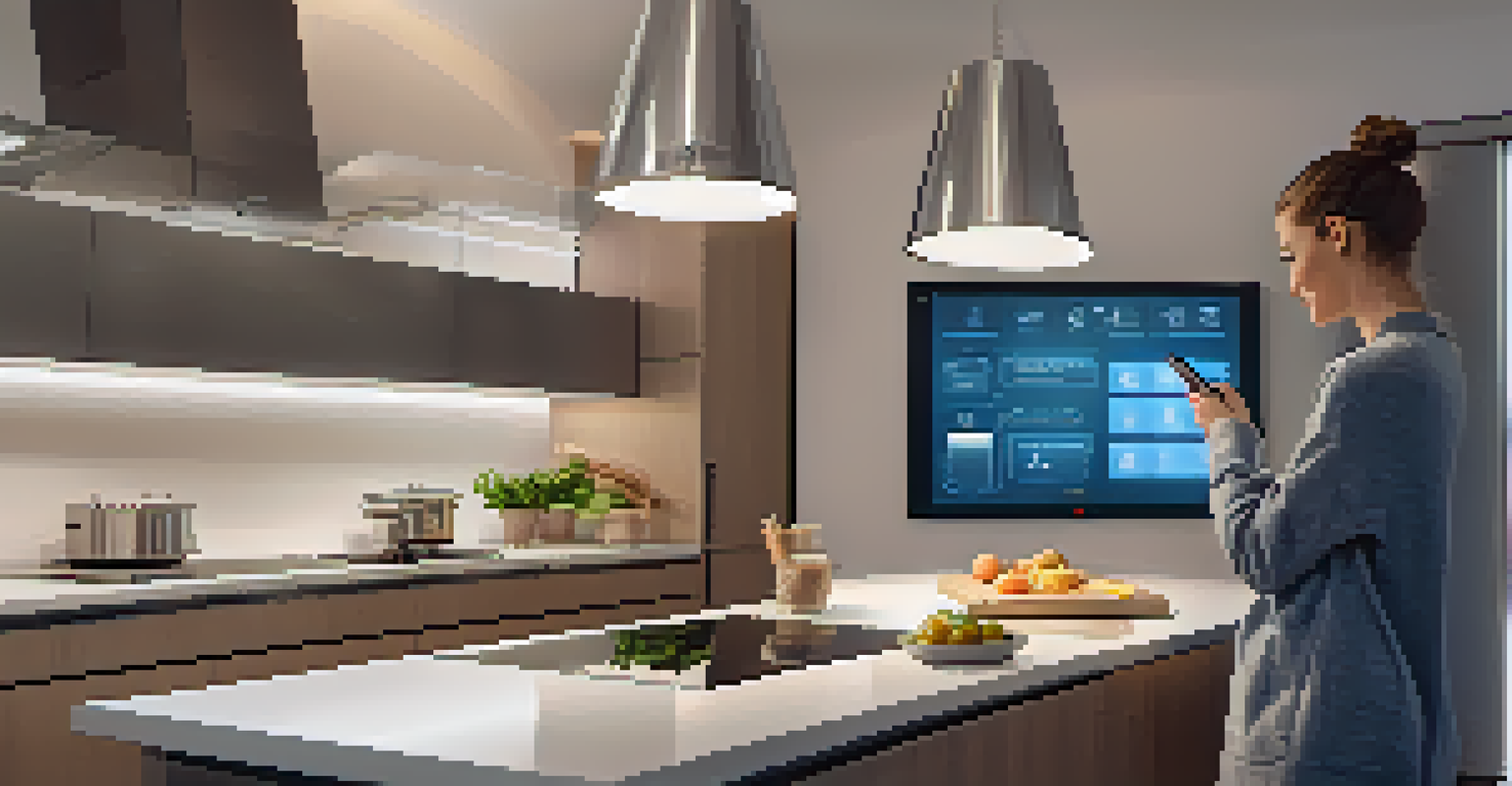Automating Your Home: A Beginner's Guide to Smart Devices

What is Home Automation and Why It Matters
Home automation refers to the use of technology to control various household functions like lighting, heating, and security from a single device. Imagine being able to turn off all your lights or adjust your thermostat with just a tap on your smartphone. This convenience not only saves time but can also enhance your home’s energy efficiency and security.
The best way to predict the future is to create it.
The beauty of home automation lies in its ability to simplify our lives. For instance, a smart thermostat can learn your schedule and adjust temperatures automatically, ensuring comfort when you're home and saving energy when you're away. This not only reduces your utility bills but also contributes to a greener planet.
Moreover, home automation can provide peace of mind. With smart security cameras and alarms, you can monitor your home from anywhere, receiving alerts directly to your phone. This level of control and awareness helps you feel safer, whether you're at work or on vacation.
Starting with Smart Devices: The Basics
To dive into home automation, start by identifying the areas you'd like to improve. Do you want to enhance security, increase energy efficiency, or simply enjoy the convenience of controlling your lights from your bed? Pinpointing your priorities will help you make informed decisions about the devices you choose.

Next, research the types of smart devices available. Common options include smart bulbs, plugs, cameras, and thermostats. These devices are often compatible with popular ecosystems like Amazon Alexa, Google Assistant, or Apple HomeKit, so consider which ecosystem you’re already invested in for seamless integration.
Home Automation Enhances Convenience
Home automation simplifies everyday tasks, allowing you to control lighting, heating, and security from your smartphone.
Once you have a few devices in mind, check for user reviews and compatibility with your home network. A little research can go a long way in ensuring that the smart devices you choose will work together smoothly and meet your expectations.
Setting Up Your First Smart Device
Setting up a smart device is often easier than you might think. Most devices come with user-friendly instructions, and many allow you to control them through a dedicated app. For example, smart bulbs typically require you to screw them in, download the app, and connect to your Wi-Fi network—simple steps that anyone can follow.
Technology is best when it brings people together.
During setup, you’ll likely need to create an account and link your smart device to your home network. This may involve scanning a QR code or entering a code provided in the app. Once connected, you’ll have the freedom to control your device from anywhere, which is part of the magic of automation.
After setup, explore the app’s features. You might be able to set schedules for your devices, create scenes that adjust multiple devices at once, or even control them with your voice. Understanding these features can help you maximize the benefits of your new smart device.
Integrating Multiple Devices for a Seamless Experience
Once you're comfortable with a single smart device, consider integrating multiple devices for a cohesive experience. For instance, you could combine smart lights, a thermostat, and a security system into a single ecosystem, allowing you to manage them all from one app or voice command. This integration can make daily tasks even simpler.
Think of it like creating a smart home orchestra; each device plays its part, working harmoniously together. For example, you can set your lights to dim when your smart TV turns on, creating the perfect movie-watching ambiance. This level of customization can enhance your lifestyle in ways you may not have anticipated.
Integrating Devices Creates Harmony
Connecting multiple smart devices into one ecosystem enables seamless control and automation, enhancing your lifestyle.
Moreover, many smart home ecosystems allow for automation routines. You might set a 'Goodnight' routine that locks the doors, turns off the lights, and sets the thermostat to your preferred sleeping temperature. Automating these actions saves time and adds a layer of comfort to your evenings.
Ensuring Security in Your Smart Home
As you embrace home automation, it's crucial to prioritize security. Smart devices often connect to your Wi-Fi network, making them potential targets for hackers. Start by ensuring your home network is secure with a strong password and consider setting up a separate network for your smart devices.
Furthermore, regularly update your devices’ firmware and software. Manufacturers often release updates to patch security vulnerabilities, so keeping your devices up to date is essential. This simple step can significantly enhance your smart home’s security.
Lastly, be mindful of privacy settings on your devices. Many smart devices collect data to improve functionality, but you have control over what data you're comfortable sharing. Review and adjust these settings to ensure your peace of mind while enjoying the convenience of home automation.
Exploring Advanced Automation Options
Once you’ve mastered the basics, you might find yourself ready to explore more advanced automation options. For instance, consider implementing smart sensors that detect motion or changes in temperature. These sensors can trigger actions, like turning on lights when you enter a room or adjusting the thermostat based on occupancy.
Another option is to set up voice control with smart speakers. This hands-free convenience allows you to control your home with simple voice commands, making multitasking a breeze. Imagine cooking dinner while instructing your smart assistant to play your favorite music or adjust the lighting.
Prioritizing Security is Essential
Securing your smart home is critical; use strong passwords, keep devices updated, and manage privacy settings.
Advanced users might also delve into programming specific routines using platforms like IFTTT (If This Then That). With IFTTT, you can create custom commands that link different smart devices together in innovative ways, expanding the possibilities of your automated home.
The Future of Smart Home Technology
Looking ahead, the future of smart home technology is bright and ever-evolving. New innovations, such as AI-driven devices that learn your habits and preferences, are on the rise. These advancements promise to make home automation even more intuitive and personalized, enhancing your daily life.
Moreover, as smart home technology becomes more mainstream, we can expect greater interoperability between devices from different brands. This means you won’t have to worry as much about compatibility issues, allowing for a more unified smart home experience.

Finally, sustainability is becoming a key focus in the smart home sector. Many new devices are being designed with energy efficiency in mind, helping you save money while also being kind to the planet. Embracing these innovations not only enhances your living space but also aligns with a growing commitment to environmental responsibility.